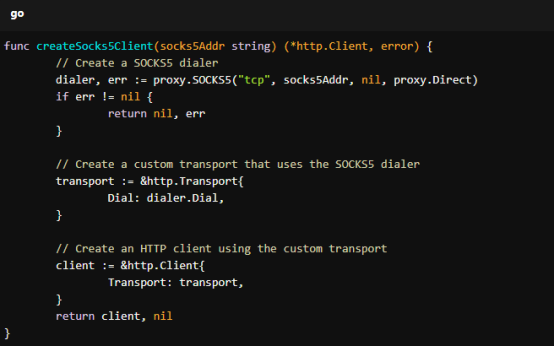Why Proxies Are Essential for Ad Verification&How to Choose
Protect your brand from ad fraud with ad verification proxies. Learn how proxies help verify ads across locations, devices, and platforms.
Post Time:2025-03-28
Discover how to configure Resty to use a SOCKS5 proxy for better privacy in your HTTP requests. Learn about SOCKS5 proxies, where to buy them, and their benefits.
Developers and businesses often need to make secure and anonymous HTTP requests. Whether scraping web data, managing multiple accounts, or bypassing geo-restrictions, proxies mask real IP addresses and route traffic through a different server, adding an extra layer of privacy and security.
Resty, a popular HTTP client for Golang, makes it easy to send HTTP requests. For further security, you can configure Resty to work with a SOCKS5 proxy. In this blog, we’ll explain how to set a SOCKS5 proxy in Resty, the benefits of using SOCKS5 proxies, and why residential SOCKS5 proxies offer superior performance.

Resty is a powerful and flexible HTTP and REST client for Go. It is designed to simplify the process of making API calls, providing a clean and intuitive interface for performing CRUD operations (Create, Read, Update, Delete) with multiple options for handling requests and responses. With features like automatic JSON handling, request retries, and middleware support, Resty is a popular choice among Go developers for building robust applications that communicate with web services.
SOCKS5 is a type of internet protocol. A SOCKS5 proxy is a highly versatile type of proxy server that stands out for its ability to handle any type of traffic, not just HTTP or HTTPS. Unlike older proxy protocols, SOCKS5 works at the transport layer, meaning it can route traffic for a wide variety of protocols such as HTTP, SMTP (email), FTP (file transfer), and even P2P (peer-to-peer) traffic.
When you connect to a SOCKS5 proxy, it doesn't modify your data packets. Instead, it simply forwards them to the destination server on your behalf. This "hands-off" approach makes SOCKS5 proxies faster and more secure than traditional HTTP proxies, which may alter data packets. This feature is especially important for tasks requiring high anonymity, such as web scraping, managing multiple accounts, or bypassing geo-blocks imposed by websites.
When you combine the power of Resty with a proxy, you unlock several key advantages, especially when performing tasks that require secure and anonymous data transfers.
One of the most common reasons is to bypass geographical restrictions. Many websites, streaming services, and platforms restrict access based on the user’s location. By routing your traffic through a proxy, you can appear to be accessing the web from a different region, allowing you to bypass these limitations.
Using a proxy with Resty ensures your IP address is hidden, making it much harder for websites or platforms to track your real location or identify your activity. This is particularly valuable for developers performing web scraping, running automation scripts, or managing multiple accounts on platforms that actively monitor IP addresses.
When using Resty with proxies, you have greater control over how requests are routed. This allows for customizable configurations, enabling you to specify which requests should use the proxy and which should connect directly to the target server.
If you're considering SOCKS5 proxy buy options for your project, investing in residential SOCKS5 proxies ensures higher anonymity and more reliable connections, especially when working with highly restrictive platforms.
SOCKS5 proxies are particularly advantageous for use with Resty due to their versatility, enhanced anonymity, and superior performance across various protocols.
SOCKS5 proxies do not impose restrictions based on the type of protocol used. They can handle various types of traffic, including TCP and UDP. This flexibility allows them to work seamlessly with different applications more than HTTP requests.
Provide a higher level of anonymity through the SOCKS5 protocol. This makes it harder for websites to trace your requests back to your original IP.
SOCKS5 proxies can efficiently handle multiple connections and different types of network traffic simultaneously, leading to better overall performance and lower latency.
Next, let’s walk through how to configure Resty to use one. Resty is a powerful HTTP client for Go, and while it doesn’t have built-in SOCKS5 support, you can easily set it up using Go’s standard libraries.
Follow these simple steps to configure Resty with a SOCKS5 proxy:
First, please install the golang.org/x/net/proxy package, supporting SOCKS5 proxies in Go.

For Copy:
go get golang.org/x/net/proxy
You need to create a SOCKS5 dialer for routing your HTTP requests through the SOCKS5 proxy server.

For Copy:
import (
"net"
"net/http"
"golang.org/x/net/proxy"
)
Create a custom HTTP client that uses this SOCKS5 dialer. Resty will use it to make HTTP requests.

For Copy:
func createSocks5Client(socks5Addr string) (*http.Client, error) {
// Create a SOCKS5 dialer
dialer, err := proxy.SOCKS5("tcp", socks5Addr, nil, proxy.Direct)
if err != nil {
return nil, err
}
// Create a custom transport that uses the SOCKS5 dialer
transport := &http.Transport{
Dial: dialer.Dial,
}
// Create an HTTP client using the custom transport
client := &http.Client{
Transport: transport,
}
return client, nil
}
Finally, integrate the custom HTTP client with Resty to route all HTTP requests through the SOCKS5 proxy.

For Copy:
import (
"github.com/go-resty/resty/v2"
"log"
)
func main() {
// Specify the SOCKS5 proxy address
socks5Proxy := "127.0.0.1:1080" // Replace with your proxy address
// Create the SOCKS5 HTTP client
httpClient, err := createSocks5Client(socks5Proxy)
if err != nil {
log.Fatalf("Failed to create SOCKS5 client: %v", err)
}
// Create a Resty client using the SOCKS5 HTTP client
client := resty.NewWithClient(httpClient)
// Perform a GET request through the SOCKS5 proxy
resp, err := client.R().Get("https://httpbin.org/get")
if err != nil {
log.Fatalf("Request failed: %v", err)
}
// Output the response
log.Println("Response:", resp.String())
}
While using a SOCKS5 proxy with Resty can be straightforward, you may encounter some common issues:
Among the different types of SOCKS5 proxies available, residential SOCKS5 proxies stand out for their high anonymity and trustworthiness. These proxies use IP addresses from real residential devices, making them far more difficult for websites to detect and block compared to datacenter proxies.
Residential proxies are less likely to be flagged as suspicious since they are from real user devices (such as home routers), like normal web traffic.
Many websites employ strict anti-bot measures, such as captchas or IP blocking. Residential proxies help avoid these issues by mimicking legitimate user behavior.
Whether you're running a large-scale web scraping operation or managing multiple social media accounts, residential SOCKS5 proxies are best for staying under the radar and avoiding detection.
If you're looking to buy SOCKS5 proxies for your project, choosing residential proxies will give you the highest success rate, especially on platforms with strict anti-bot policies.
Using SOCKS5 proxies with Resty is an excellent way to enhance your HTTP requests by adding extra security, privacy, and flexibility. Whether bypassing geo-restrictions, performing web scraping, or managing multiple accounts, configuring Resty to use a SOCKS5 proxy ensures a secure and anonymous connection. For better results, please consider using residential SOCKS5 proxies.
Explore our range of high-quality SOCKS5 proxies. Cheap datacenter SOCKS5 proxies and premium residential SOCKS5 proxies. Get Started Today!
Q: What is the difference between SOCKS5 and HTTP proxies?
A: While HTTP proxies only handle web traffic, SOCKS5 proxies are protocol-agnostic and can manage more complex traffic types, making them more versatile. Additionally, SOCKS5 supports UDP (User Datagram Protocol), which is critical for applications that require low-latency data transfers, such as video streaming or online gaming.
Q: Can I use Resty with other types of proxies?
A: Yes, Resty can be configured to use various types of proxies, including HTTP and HTTPS proxies. However, SOCKS5 proxies are recommended for their versatility.
Q: Are there any performance impacts when using a proxy?
A: Yes, using a proxy can introduce latency, as your requests must first go through the proxy server. However, the trade-off in privacy and security often justifies this impact.
< Previous
Next >